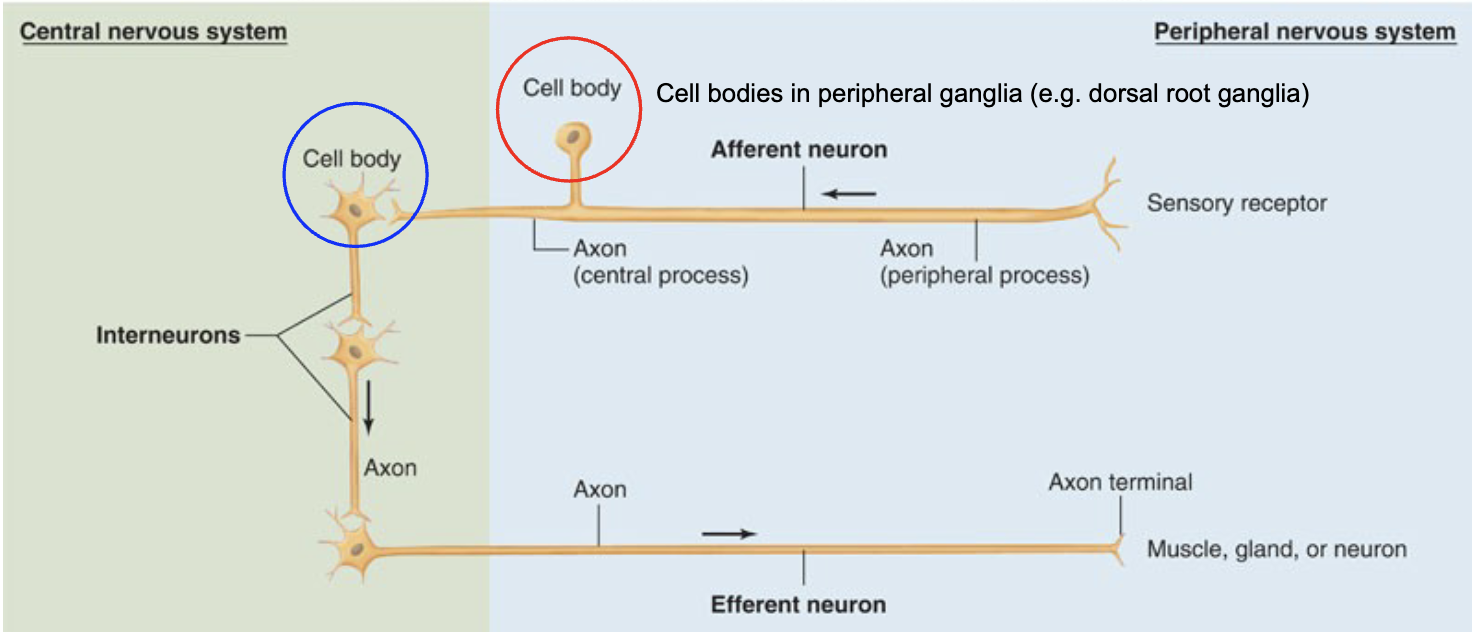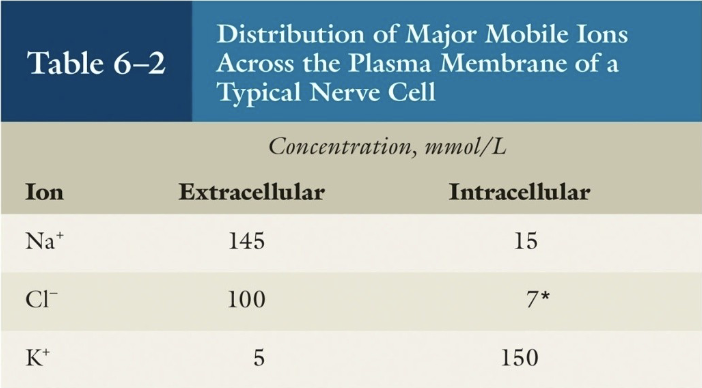Lecture 2 - Neural Tissue and Membrane Potentials
1/39
There's no tags or description
Looks like no tags are added yet.
Name | Mastery | Learn | Test | Matching | Spaced |
|---|
No study sessions yet.
40 Terms
Central nervous system (CNS)
Brain, spinal cord
Peripheral nervous system (PNS)
Sensory/Somatic
Autonomic
Sympathetic (fight or flight)
Parasympathetic (rest and digest)
Neuron
Basic functional unit of the nervous system
dendrite
axon
initial segment
Dendrites
receive information via neurotransmitters
Axons
Conduct action potentials, send signals towards axon terminals
Initial segment (axon hillock)
– AP trigger zone
Glial cells
Supporting cells of CNS and PNS
Constitute ~90% of cells in CNS (~50% volume)
Surround the soma, axon, and dendrites of neurons
Provide physical and metabolic support and much more
Astrocytes
Spatial buffering of extracellular K+
Neurotransmitter uptake and release
Provide metabolic support to neurons
Guide neuronal migration in developing brain
Promote myelinating activity of oligodendrocytes
Mediate neurovascular coupling
Modulation of synaptic activity
Nervous system repair
Oligodendrocytes
Myelinate multiple CNS axons, provide trophic support
Myelin composed of highly compacted layers (20- 200) of modified PM
Compact myelin speeds up conduction
Electrical insulator
Nodes of Ranvier
Spaces between adjacent sections of myelin - axon’s PM exposed to ECF → saltatory conduction
Schwann Cells
Myelinate PNS axons.
Nuclei closely apposed to axon
Pain and temperature fibers are unmyelinated
Non-myelinating SCs can myelinate if triggered by neurons
Microglia
Macrophage-like cells that reside in the CNS; proliferate and activate in response to injury
Ependymal cells
Line the fluid filled cavities of the brain; produce CSF
Anterograde axonal transport
Towards dendrite
Synaptic proteins
Neurotransmitters
Certain mRNAs
Retrograde axonal transport
Towards cell body
Growth factors
Functional classes of neurons
Groups of afferent and efferent neurons form the nerves of the PNS (they are all bundled together).
Note that a nerve fiber is a single axon, and a nerve is a bundle of axons

Synaptic inputs
Axo-dendritic, axo-somatic and axo-axonic
A single neuron can be postsynaptic to one cell and presynaptic to another cell
Presynaptic
A neuron that conducts a signal towards a synapse
Postsynaptic
One that conducts signal away from the synapse
Electrical potential
Separate charges have the ability to do work
Potential differences
Difference in charge between 2 points, measured in volts
Current
Movement of electrical charge
Ohm’s law
Current proportional to the potential differences and inversely proportional to the resistance (hindrance to charge flow)
I=(V/R)
Insulator
Substance with high electrical resistance
Conductor
Substance with low electrical resistance
Summary: Na+/K+ ATPase
The Na+/K+ ATPase establishes concentration gradients of Na+ and K+ across the plasma membrane (high Na+ outside and high K+ inside)
Recall that the pump uses up to 40% of the ATP produced by the cell
At a steady state, ion fluxes through “leak” channels and activity of the pump balance each other
Distribution of Ions in a Nerve Cell
Na+, K+ and Cl- are present in the highest concentrations - membrane permeability to each is independently determined.
Remember: Na+ Cl- out, K+ in
There are many other ions, including Mg2+, Ca2+, H+, HCO3-, HPO42-, SO42-, amino acids, and proteins in ICF and ECF

Consider a membrane that is permeable only to K+:
a) No potential difference because (+) and (-) ions are equal and channels are closed.
b) If K+ channels open, K+ will diffuse from C2 C1
c) C1 will have an excess of (+) charges and C2, an excess of (-) charges.
d) Additional charge separation
e) The buildup of (+) charges in C1 and (-) charges in C2 produces an electrical potential that exactly offsets the [K+] gradient.
• The membrane potential at which the K+ flux due to the concentration difference becomes equal in magnitude but opposite in direction to the K+ flux due to charge separation is called the K+ equilibrium potential.
In this experimental setup...
• What happens if we increase [K+] in C2? → equilibrium potential will need to be greater
• What happens if we increase [Na+] in C1? → nothing would happen (Na independent, unless it affects electrical potential)
![<p>a) No potential difference because (+) and (-) ions are equal and channels are closed.</p><p>b) If K+ channels open, K+ will diffuse from C2 C1</p><p>c) C1 will have an excess of (+) charges and C2, an excess of (-) charges.</p><p>d) Additional charge separation</p><p>e) The buildup of (+) charges in C1 and (-) charges in C2 produces an electrical potential that exactly offsets the [K+] gradient.</p><p>• The membrane potential at which the K+ flux due to the concentration difference becomes equal in magnitude but opposite in direction to the K+ flux due to charge separation is called the K+ equilibrium potential.</p><p></p><p>In this experimental setup...</p><p>• What happens if we increase [K+] in C2? → equilibrium potential will need to be greater</p><p>• What happens if we increase [Na+] in C1? → nothing would happen (Na independent, unless it affects electrical potential)</p>](https://knowt-user-attachments.s3.amazonaws.com/12a1c7f3-167d-4269-8126-e1dede587d96.png)
Consider a membrane that is permeable only to Na+:
a) No potential difference because (+) and (-) ions are equal and channels are closed.
b) If Na+ channels open, Na+ will diffuse from C1 C2
c) C2 will have an excess of (+) charges and C1, an excess of (-) charges.
d) Additional charge separation
e) The buildup of (+) charges in C2 and (-) charges in C1 produces an electrical potential that exactly offsets the [Na+] gradient.
• The membrane potential at which the Na+ flux due to the concentration difference becomes equal in magnitude but opposite in direction to the Na+ flux due to charge separation is called the Na+ equilibrium potential.
In this experimental setup...
• What happens if we increase [Na+] in C1? → increase equilibrium/ electrical potential needed
• What happens if we increase [K+] in C2? → no effect
![<p>a) No potential difference because (+) and (-) ions are equal and channels are closed.</p><p>b) If Na+ channels open, Na+ will diffuse from C1 C2</p><p>c) C2 will have an excess of (+) charges and C1, an excess of (-) charges.</p><p>d) Additional charge separation</p><p>e) The buildup of (+) charges in C2 and (-) charges in C1 produces an electrical potential that exactly offsets the [Na+] gradient.</p><p>• The membrane potential at which the Na+ flux due to the concentration difference becomes equal in magnitude but opposite in direction to the Na+ flux due to charge separation is called the Na+ equilibrium potential.</p><p></p><p>In this experimental setup...</p><p>• What happens if we increase [Na+] in C1? → increase equilibrium/ electrical potential needed</p><p>• What happens if we increase [K+] in C2? → no effect</p>](https://knowt-user-attachments.s3.amazonaws.com/9994a6be-ebf6-468c-a4b8-92c7a96edeed.png)
The Nernst Equation
Describes the equilibrium potential for any ion species
The electrical potential necessary to balance a given ionic concentration gradient across a membrane so that the net flux on that ion is zero
Eion = 61/Z log (Co/Ci)
Where,
Eion = equilibrium potential in mV
Ci = intracellular ion concentration
Co = extracellular ion concentration
Z = valence of the ion
61 is a constant that takes into account the universal gas constant, the temperature, and the Faraday electrical constant
The Resting Membrane Potential Charge
A voltmeter measures a potential difference across the membrane of a resting neuron (millivolts) of –70 mV.
ECF assigned a voltage of zero
If the potential across membrane is 70 mV and the cytoplasmic side of membrane has excess negative charge, then the membrane potential is -70 mV
Resting membrane voltages range from _________ in different cells. The membrane is said to be ________
–50 to – 100 mV
polarized
Membrane potential determined by two factors:
1. Differences in ionic composition of ICF and ECF
2. Differences in plasma membrane permeability to each ion
Charge Separation Across the Plasma Membrane
Voltage occurs only at membrane surface
Tiny excess of (-) ions along the inner surface of the PM and (+) ions around the outside.
Excess charges collect at plasma membrane and are attracted to each other.
The bulk of the ECF and ICF remains electrically neutral.
The actual number of charges that are separated is infinitesimally small compared to total number of charges in the cell.
Only a very thin shell of charge difference is needed to establish a membrane potential
Leak channels generate what?
Resting potential
Leak channels
Integral membrane proteins that are selective ion channels - some always open.
In an actual neuron at rest, there are many more open K+ leak channels than Na+ leak channels.
So PM is 25 times more permeable to K+ than Na+
This bring RMP closer to the K+ equilibrium potential
Therefore, the RMP depends mostly on [K+]. Clinically relevant. – Na+/K+ ATPase maintains resting membrane potential by maintaining concentration gradients
Forces Influencing Na+ and K+ at Rest
At a resting membrane potential of -70 mV both the concentration gradient and electrical potential favor inward movement of Na+, while the K+ concentration gradient opposes the electrical potential.
The greater permeability and movement of K+ maintains the resting membrane potential at a value near Ek.
The Goldman-Hodgkin-Katz Equation
How do we calculate the membrane potential if more than one type of channel is open?
We need to consider the permeability (P) for each ion species (how many channels are open) and the concentration difference.
The GHK equation is essentially a modified form of the Nernst equation that takes into account the individual ion permeabilities.
Vm = 61 log {PK[Ko] + PNa[Nao] + PCl[Cli]} / {PK[Ki] + PNa[Nai] + PCl[Clo]}
Note that for chloride, [Cli] is in the numerator instead of the denominator. This is because it is a negatively charged ion
E(Na+)
61/1 log (145/15) = +60 mV
log>1 = +#
E(K+)
61/1 log (5/150) = -90 mV
log<1 = -#